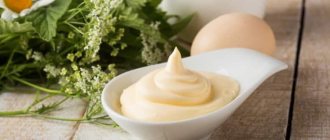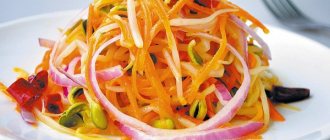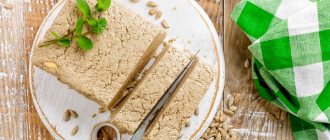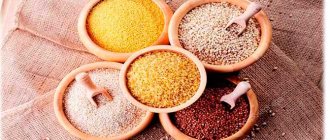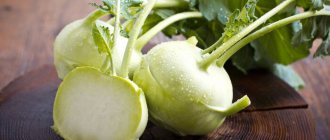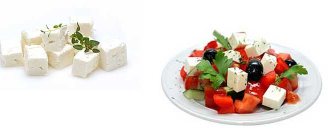Bright, aromatic parsley can improve the results of any diet and help transform your figure. Find out everything about the calorie content of parsley and how to store it. Get recipes and say “bye” to those extra pounds!
Author: Kristina Lobanovskaya, doctor, practicing nutritionist Article updated: 11/09/2020
Parsley is a biennial plant of the Apiaceae family. The homeland of greenery is the Mediterranean coast, or rather Spain, where it is still found growing wild on rocky slopes. It is noteworthy that in translation from Greek parsley sounds like “stone,” which explains its favorite place to grow. Alluvial soil, deep and fertile, she occupies no less willingly. In ancient times, the herb was praised and cultivated in Greece, and by the Middle Ages, the herb was popular in Western Europe. In Russia, greens have been known since very distant times, and today it is difficult to imagine your diet without aromatic herbs. The calorie content of parsley is 47 kcal per 100 grams, which makes it especially suitable for use by those losing weight.
Properties of parsley
Nutritional value and composition | Vitamins | Minerals
How much does parsley cost (average price for 1 bunch)?
Moscow and Moscow region.
16 rub.
The homeland of this greenery is the eastern coast of the Mediterranean Sea, more specifically Spain. There parsley is still found growing wild among the rocks, but close to water sources. The name parsley comes from the Greek word “petros”, which means “stone”, indicating the favorite place for the greenery to grow. In Greece, parsley began to be grown since ancient times, where it became a symbol of glory and joy. From the 9th century it began to spread throughout Europe.
Parsley was originally used as a medicine to heal wounds from poisonous insect bites. It was for this purpose that parsley began to be grown in Russia. Later, people realized that greens go well with vegetables, both fresh and stewed, as well as fish and meat. It is especially valuable that even with prolonged heat treatment, the beneficial properties of parsley are preserved, and its taste is only enhanced. The same is true with freshly frozen greens - nutrients and, accordingly, benefits for the body can be preserved in them for several months. The calorie content of parsley reaches 49 kcal. per 100 gr.
Frozen
In winter, when vitamin deficiency sharply increases, parsley from the garden becomes a real luxury. But it is thanks to her that it is possible to give summer freshness to dishes and enrich them with benefits. The optimal solution is freezing. Parsley in this case looks like a particularly good option, since it does not change its chemical composition at all when placed in the freezer. Another plus is that there is no need for thawing: you can add frozen spice to dishes and drinks straight from the freezer. And, unlike dried greens, frozen greens do not lose their attractiveness and color.
There are several ways to freeze grass leaves (calorie content will depend on the one you choose):
- Crumbly. This option is most successful if you want to use it all winter not only as an ingredient in dishes, but also as a decoration. A bunch of grass is washed and the stems are cut off. The remaining leaves are cut and laid out on paper until completely dry. Afterwards, the workpiece is poured into a special bag or food container and sent to the freezer. The calorie content of greens when frozen this way is 49 kcal per 100 grams, which corresponds to the calorie content of a fresh plant.
- Portioned. This option for freezing leaves is convenient when used for preparing soups, side dishes, etc. A fresh bunch of plants is washed, dried and freed from the stems, after which they are finely chopped. Take a plastic bag and divide it into “squares”. Place a tablespoon of greens on each and carefully tie it with thread at the base. Subsequently, the portioned bags are placed in the freezer. The calorie content of the preparation per 100 g is 48 kcal.
- Cubes. If you don’t want to bother with bags every time you cook, you can freeze the juicy leaves using an ice container. Surprisingly, the calorie content of parsley prepared for winter in this way is only 6 kcal per 100 grams. This is easy to explain - the recipe calls for plain water. So, first of all, the bunch is washed and dried, then the stems are cut off, and the greens are finely chopped. Place a pinch in each cell of the ice container, and then fill it with cooled boiled water. Once the entire mold is filled, put it in the freezer. After a few hours, the fragrant cubes can be removed from the mold and transferred to a bag.
Another way to prepare parsley for winter involves freezing the entire bunch. You don’t need to cut anything - just wrap the leaves along with the stems in cling film or place them in a special container. Frozen parsley in any of the options can be used equally with fresh, that is, added to first and second courses, salads, cocktails, etc.
The advantage of freezing as a method is that the greens can retain their beneficial properties for two years.
Parsley root is frozen less frequently than leaves and stems, but it can also serve well in winter. This is an excellent addition to soups, especially dietary ones, and main courses. Meat stuffed with frozen root, beef or pork, turns out appetizing. 100 grams of frozen root contains 51 kcal, so during weight loss it can be used without fear of increasing the calorie content of dishes too much.
It doesn't take much time to create a blank. To begin with, the roots are freed from the green part, then the soil is shaken off and washed thoroughly. Lay out on a clean towel and allow to dry. Next comes the peeling stage, after which the roots are cut into small pieces and laid out for distribution. In this form, the roots are sent to the freezer, and after 2 hours they are taken out, put into bags, and returned to the cold again. Preliminary defrosting of the product for use in the cooking process is not required.
When frozen, both parsley and the root are a source of many minerals and vitamins, so in addition to giving dishes a special taste and a hint of spice, they help:
- strengthen the immune system;
- normalize digestion;
- calm your nerves;
- strengthen teeth;
- reduce blood glucose levels;
- normalize metabolism.
Benefits of parsley
What is the secret of the miraculous properties of parsley? First of all, it contains a lot of vitamin C, significantly exceeding the same value in many vegetables and fruits. So 100 gr. Parsley contains almost two daily requirements of this invaluable vitamin. Thus, parsley is ideal for strengthening the immune system, for the treatment and prevention of seasonal vitamin deficiency, and scurvy. In terms of the amount of carotene, parsley is in no way inferior to carrots. In addition, it contains a significant amount of vitamins B1, B2, folic acid, potassium salts, iron and magnesium.
A unique substance, inulin, which is part of parsley, regulates the processes of glucose metabolism in human blood. Therefore, the benefits of parsley are revealed in the fight against diabetes. Parsley is also useful for various kidney diseases, bloating, intestinal colitis, gastritis, ulcers, and in general for any inflammatory processes and weakened vision. Parsley is indispensable for the fight against edema, of various origins - both renal and cardiac. Parsley also has an amazing effect on the oral cavity - it perfectly whitens teeth and strengthens the health of gums.
In addition to leaves, parsley seeds and roots are actively used in folk medicine. A decoction of them helps in eliminating freckles, age spots and acne on the face. After applying the decoction, the skin becomes fresher, the delicate skin around the eyes is toned and becomes smoother, facial wrinkles are smoothed out. Parsley also has a beneficial effect on hair growth; compresses made from crushed seeds are used to prevent baldness.
Chemical composition and nutritional value of parsley
The calorie content, protein, fat and carbohydrate content (BPJU) in parsley is important to know for people on a diet. And, of course, to everyone who is attentive to the composition of the products in their diet.
Proteins, fats and carbohydrates
The ratio and content of BJU varies depending on the parts of the plant used and the form in which it is consumed.
| Vegetable part/condition (fresh, frozen, dried) | Squirrels | Fats | Carbohydrates |
| Fresh root | 4 | 0 | 8 |
| Fresh greens | 3,7 | 0,4 | 7,6 |
| Frozen root | 2 | 1 | 10 |
| Dried parsley | 22,4 | 4,4 | 21,3 |
| Frozen greens | 3,5 | 0 | 8 |
Glycemic index
The GI of the green part of parsley is 5 units . Due to the low glycemic index and rich chemical composition of parsley, its greens practically do not increase blood glucose and do not provoke the formation of fatty deposits. The benefits of the vegetable remain as long as it has elastic, juicy stems and bright greens.
Leafy vegetable has a low GI
To prolong freshness, the product is placed in a cellophane bag and sent to the Fresh Zone of the refrigerator. In this case, the leafy vegetable will last a week longer than just on the shelf without any protection.
Vitamins
The vitamins contained in parsley bring great benefits to humans, affecting various organs and systems.
There is more vitamin C in parsley than in lemon
- Choline (B4), 12.8 mg. Protects the human brain, ensures stable functioning of the psyche, and promotes the rapid transmission of nerve impulses.
- Niacin (nicotine, vitamin PP). 1.6 mg. Lowers bad cholesterol, is an anticoagulant, dilates blood vessels.
- Phylloquinone (K), 1640 mcg. Regulates the process of blood clotting, has an antibacterial, analgesic effect, forms and restores bone tissue.
- Biotin (H), 0.4 mcg. A microvitamin necessary for gas exchange, normalization of blood glucose, and interaction with insulin.
- Tocopherol (E), 1.8 mg. Necessary for improving cellular nutrition, tissue regeneration, strengthening blood vessels and maintaining their elasticity.
- Retinol (A), 950 mcg. The vitamin is necessary for protein synthesis and the proper functioning of the immune system.
- Ascorbic acid ©, 150 mg. Regulates metabolic processes and is important for regenerative processes.
- Folic acid (B9), 110 mcg. Helps lower cholesterol and normalize blood pressure.
- Thiamine (B1), 0.05 mg. This vitamin contained in parsley is involved in carbohydrate, water-salt, fat, and energy metabolism, normalizes appetite, and participates in the neutralization of toxins.
- Pyridoxine (B6), 0.18 mg. Improves brain function, promotes concentration and improves memory.
- Pantothenic acid (B5), 0.05 mg. It is important for maintaining the beauty of the skin, participates in the breakdown of carbohydrates, fats, amino acids, proteins with the release of energy resources.
- Riboflavin (B2), 0.05 mg. The vitamin contained in the leafy vegetable is necessary for the formation of red blood cells and antibodies.
Macro- and microelements
Parsley contains a large number of nutrients that help all human organs function normally and fully.
Parsley is a storehouse of vitamins and microelements
The chemical composition of parsley in the table shows what elements this spice is rich in.
| Name | Quantity | Beneficial features |
| Manganese | 0.16 mg | This element is concentrated in the brain, kidneys, pancreas, and liver. Improves the functioning of the central nervous system, improves the metabolism of lipids and carbohydrates. |
| Selenium | 0.1 mcg | A powerful antioxidant responsible for longevity. Prevents the appearance of tumors, stimulates metabolite processes, protects the heart and blood vessels from pathologies. |
| Iron | 1.9 mg | A necessary element for normal blood formation in the spleen and red bone marrow. Thanks to its presence, the body systems are actively and fully supplied with oxygen. The immune system works smoothly. |
| Copper | 149 mcg | Increases immunity, improves the production of vital energy by cells. |
| Magnesium | 85 mg | It is called the metal of life, as it supports the functions of all important human organ systems (central nervous system, cardiac, digestive, hematopoietic). |
| Zinc | 1.07 mg | It is part of hormones and enzymes that ensure stable functioning of the central nervous system. |
| Calcium | 245 mg | The element is necessary for the construction and further preservation of bone tissue and tooth enamel in a normal state. Calcium protects the body from stress, allergies, and free radicals. |
| Phosphorus | 95 mg | Necessary for metabolism, the functioning of the kidneys, heart muscle and blood vessels, the formation of bones and teeth. |
| Sodium | 34 mg | Maintains water balance, conducts nerve impulses, stimulates digestion. |
| Potassium | 800 mg | Participant in many vital processes. Important for the functioning of muscle tissue, the heart (especially the myocardium), and for the regulation of water metabolism. |
Other product nutrients
In addition to the vitamin-mineral complex, parsley contains 2.1 g of dietary fiber, 1.1 g of ash, 0.1 g of saturated fatty acids, 6.4 g of sugars.
The leafy vegetable contains many nutrients
How is culture useful and harmful?
After considering the chemical composition and KBJU, there would seem to be no doubt about its absolute benefits. But is it? Let us consider in detail what advantages and disadvantages “growing on a stone” has.
Benefit:
- strengthening the immune system;
- beneficial effect on blood composition (stimulation of blood cell production, normalization of hemoglobin levels);
- strengthening the walls of blood vessels;
- prevention of inflammation of the oral mucosa and removal of unpleasant odors;
- reducing the acidity of gastric juice;
- removal of toxins from the body;
- decreased blood glucose levels (due to low GI);
- normalization of vision;
- reduction of gas formation;
- treatment and prevention of arthritis;
- for women: normalization of the menstrual cycle, reduction of periodic pain;
- for men: increased potency and improved condition of the genitourinary system.
Harm to the plant:
- It is not always possible to guarantee that parsley was grown in the right conditions without the use of chemicals. Therefore, there is a risk of harming yourself even in the absence of contraindications.
- Excessive consumption of parsley leads to excess myristicin (one of the essential oil elements). This may cause dizziness and nausea.
- If there are contraindications, eating parsley provokes a worsening of the condition.
Conditions for which it is recommended to minimize the use of parsley:
- kidney diseases;
- urolithiasis disease;
- gout;
- age up to one year;
- epilepsy;
- pregnancy (what are the benefits and harms of parsley during pregnancy and lactation?);
- individual intolerance.
We also wrote about the benefits and harms of parsley in this material.
Every housewife knows how and in what dishes to use parsley in the kitchen. But you should always approach cooking with caution. It is important to know the benefits of using a product and what effect it has on the body.
Calorie content of pumpkin
Pumpkin is one of the healthiest foods. The pulp of this vegetable contains many compounds beneficial to humans. Pumpkin is a champion in iron content. That is why this vegetable is used in diets for the prevention and treatment of atherosclerosis.
| Calories | 22 kcal |
| Squirrels | 1 g |
| Fats | 0.1 g |
| Carbohydrates | 4.4 g |
| Cellulose | 2 g |
| Water | 92 g |
| Pumpkin puree | 88 kcal |
| Roasted pumpkin | 76 kcal |
| Stewed pumpkin | 189 kcal |
| pumpkin juice | 38 kcal |
Using pumpkin juice, you can strengthen the walls of blood vessels and suppress the growth of tuberculosis bacillus. It is useful to eat 2-3 pieces of pumpkin after a “heavy” meal. This will make it easier for the stomach and help the beneficial compounds in the dish be better absorbed.
What else is useful to know about parsley?
How to choose the right parsley
Parsley is considered one of the most unpretentious plants; growing it in your own garden or even on a windowsill is not difficult.
However, if this is not possible, it is worth taking note of a few simple recommendations that will help you choose a quality product on the shelves of markets and stores:
- The easiest way to determine the freshness of parsley is by the cut on the stem: if it is fairly dry, rotten and emits an unpleasant odor, it is unlikely that such a product should be purchased;
- a limp stem is another sign of a stale product;
- Depending on the variety, parsley leaves can be either bright green or yellowish-green, in either case there should be no brown, limp leaves.
Video: “How to keep parsley fresh?”
How to preserve the beneficial properties of parsley for a long time
There are several ways to prolong the freshness of parsley:
- pour cold water into a glass or jar and place the parsley as if in a vase (in this form the plant will remain fresh at room temperature for 1-2
days); - wrap the parsley in cling film or put it in a plastic bag and put it in the vegetable compartment in the refrigerator (this method will allow you to preserve all the nutritional and taste properties of the parsley for a week);
- place the parsley in a container for freezing or wrap it in cling film and put it in the freezer (frozen parsley can be stored from several months to 1 year);
- chop the parsley, sprinkle it with salt, if desired, you can also add other herbs and spices, put in a sterilized jar, close tightly and store in the refrigerator.
Parsley seeds keep well at room temperature in a dry, dark place.
The roots of the plant can be stored in the refrigerator in the vegetable compartment or frozen.
Areas of use of parsley
Translated from Greek, the word “parsley” is translated as “rock celery.” The plant received this name, most likely, for its unpretentiousness.
The widespread use of parsley has ensured that humanity has learned to find many uses for it.
- In cooking, parsley is considered one of the most popular herbs, allowing it to give a dish a special originality, refined and unique taste and aroma. Parsley is very often added to salads, and its roots are also added to soups and all kinds of side dishes. Chefs from all over the world note that it is especially good to use the plant as a seasoning for fish dishes.
- In folk medicine Juice, decoctions, infusions and
powders that are used in the treatment of many ailments. In official medicine, parsley essential oil is also used for the manufacture of certain pharmacological preparations. However, in 2011, a decree came into force according to which curly parsley essential oil is prohibited from being used in the production of biologically active food additives. - Among the many beauties who actively use home remedies for personal care, parsley has long been used as an excellent cosmetic product. As part of homemade masks, infusions and creams, this plant provides a rejuvenating effect, nourishes and moisturizes the skin, discolors age spots and freckles.
Oils
Not only the leaves with stems and roots of parsley are used for food purposes - the oil is no less in demand. It is extracted from the seeds of a plant, the composition of which is much richer in oils compared to other parts. The main components of the product are apiol, apiolaldehyde and pinene. However, the oil from the green part is more aromatic, and therefore acts as a good flavoring agent for meat dishes, vegetables, sauces and drinks. The calorie content of parsley oil is high - 899 kcal per 100 grams. But the benefits are obvious: when consuming oil, a person receives a tonic, diuretic, antispasmodic and mild laxative effect. For pathologies of the gastrointestinal tract and nervous system, the oil looks like a high-quality medicine. Its content of large amounts of vitamin C and iron provides a beneficial effect on the circulatory and immune systems.
Dishes
Many people think that they can benefit from a plant, for example, by simply chewing the leaves. In fact, scientists have been able to prove that it is much more beneficial to use parsley in preparing drinks and dishes by first cutting or grinding its parts. The recipes themselves, which can be not only tasty, but also useful if you want to lose weight, are quite enough.
Juice
Freshly squeezed parsley juice is not only an excellent medicine, but also an excellent culinary product. The calorie content for every 100 grams is 49 kcal, which seems to be a good indicator for use during weight loss. The juice seems especially appropriate as an ingredient in vitamin cocktails. Moreover, you can mix it not only with vegetable juices, but also with fruit juices. Of course, getting a large amount of juice is not easy, because the plant is inferior in juiciness to, say, celery, but it is quite possible. To do this, 2-3 bunches of grass along with the stems are thoroughly washed, then passed through a juicer or crushed in a blender (the resulting slurry is thrown onto a sieve and waited until the juice drains).
Compared to other vegetable juices, plant juice is recommended to be consumed in small doses. This is due to the highest biological activity.
Freshly squeezed juice does an excellent job of normalizing the activity of the adrenal glands and thyroid gland. The unique chemical composition of the liquid helps with dysfunction of the genitourinary system. When drinking juice, blood vessels are cleansed, vascular elasticity increases, and blood clots are prevented. Juice, like the fresh product, contains natural antioxidants, which allows it to effectively eliminate inflammation and toxins.
Drink
A kefir-based parsley drink is a good choice for colon cleansing. It is recommended for inclusion in the diet of those losing weight, since it has a low calorie content - 42 kcal per 100 grams. You can drink the drink at any time of the day, but the best time is considered to be afternoon tea. By the way, it is quite possible to spend a fasting day on it.
The drink is prepared in this way: add half a teaspoon of ground ginger root and 20 grams of fresh herbs, previously finely chopped, to a glass of low-fat kefir. Mix everything and use immediately.
Souffle
A delicate dietary soufflé with parsley is a suitable idea not only for children’s, but also for diet menus. There are only 61 kcal per 100 grams. With such a low calorie content, it is quite possible to consume soufflé even in the evening. In addition to normalizing the functioning of the gastrointestinal tract, the snack helps to improve the body’s protective functions.
To prepare the soufflé, take 20 g of pistachios. Peel and blend in a blender to obtain a paste-like mass. Prepare 200 g of parsley and fresh spinach in the same way. Add 50 ml of water and mix again with the pistachios. Then, using a blender, turn 100 g of tofu cheese into a paste-like mass. Add 4 egg whites and beat again. Mix both masses. Transfer to a container for cooking in the oven. Bake for 8 minutes at 180 degrees.
Salad with radishes
Low-calorie salad - 50 kcal per 100 grams - is prepared from radishes, parsley and wild garlic. Cut 400 grams of radish into half rings into several servings and chop a bunch of greens. The ingredients are mixed and seasoned with a small amount of olive oil. A light low-calorie salad can be considered an excellent choice for a diet.
Omelette
An omelet using the green part of the plant is a wonderful variation on the theme of a dietary breakfast. This start of the day will be especially useful for physically active people. The calorie content is low - 100 grams of the finished omelette contains 134 kcal.
To prepare, take several chicken eggs and 100 ml of low-fat milk. Beat with a whisk and add spices to taste. Add a bunch of chopped herbs to the mixture and mix again. Pour into a frying pan greased with olive oil, cover with a lid and simmer until done.
Broth
Broth with chicken dumplings and plant root is recommended for consumption during forced stay on medical nutrition and diet for weight loss. Low calorie content - 65 kcal per 100 g - allows you to use it both during the day and in the evening.
To start, take three chicken legs. Wash and separate the meat from the bone (no skin needed). The bones are placed in a saucepan with 2.5 liters of water. Bring to a boil, skim off the foam and leave to cook for 2-2.5 hours. 30 minutes before the end of cooking, add one chopped onion, chopped carrots, chopped parsley root, as well as spices (turmeric, ground black pepper, allspice and sea salt). The meat cut from the bones is boiled and placed in a blender along with 100 ml of heavy cream and ground white pepper. Scroll until a paste-like mass is obtained. Separately, beat several egg whites and combine with the paste. The broth is filtered. Return the carrots and bring to a boil. Carefully spoon chicken paste into the boiling liquid. Cook for about 15 minutes. Before serving, sprinkle the dish with chopped parsley.
Canned
Canning is a convenient way to store parsley for future use. Thanks to its addition, you can flavor and give a slightly spicy taste to various dishes. More often than usual, the canned plant is added to soups and borscht. It is noteworthy that, unlike dried, canned can be used in preparing dishes that do not require heat treatment. Even after preservation, the herb retains its rich taste and persistent aroma, so it is recommended to add it sparingly.
Despite processing, the grass retains a number of beneficial qualities. Its effect on the digestive system and oral cavity will be beneficial.
The process of canning parsley is simple: it is washed and chopped along with the stems, which are no less aromatic and healthy, and then placed in pre-sterilized jars. Place 1 aspirin tablet on top (per 1 liter jar) and pour boiling water over it, then roll it up. The calorie content of 100 grams of the product is 40 kcal, so it can be used not only in ordinary everyday nutrition, but also in therapeutic and dietary nutrition.
Ready-made canned greens are used as a flavoring additive to dishes and consumed as a savory snack, that is, on their own.
Parsley: calorie content and nutritional value – Health Portal
Parsley is an inconspicuous but irreplaceable “resident” of any garden. Vegetable growers willingly grow the spice in their summer cottages. And there are reasons for this. What is the secret of the popularity of parsley? The chemical composition and nutritional value of this plant give an excellent idea of its wonderful properties.
What it is
Parsley (Petrocelinum) is a biennial plant from the Apiaceae family. It grows up to 100 cm in height. Its stem is straight and branched. The root has a thickened shape.
The leaves of the plant are triangular, shiny, dark green in color with a slight glossy sheen on the upper side. The flowers are small, greenish-yellow. The oblong-shaped fruits appear in August. The crop grows in wild or cultivated form.
Currently, there are many varieties of this plant. The most popular variety is curly parsley (Petrocelinum crispum).
A little history
The plant has been known since ancient times. The Mediterranean coast is considered its homeland. However, early mentions of parsley survive in ancient Egyptian texts.
Legend has it that the plant grew on the site where a competition took place between the gods: Horus and Set, and was sprinkled with blood. Parsley was brought to Europe by the ancient Romans, who used the leaves of the plant to treat various diseases.
In cooking, parsley (the chemical composition is discussed below) began to be used later.
In Russia, the crop began to be grown at the beginning of the 19th century. The vegetable plant was called “bride” or “petrosilia”. Many folk superstitions, ceremonies, and rituals are associated with parsley. The plant has been cultivated everywhere since the 20th century. The spice became widespread in Europe, North America, and China. The crop tolerates frost well and prefers moist soil.
The nutritional value
Parsley is the leader in vitamin content among vegetable crops. The plant contains vitamins B, K, PP, and beta-carotene. Just 100 g of spicy herb can provide a person with a daily dose of ascorbic acid. Vegetables contain more of it than citrus fruits.
Parsley is a green herb whose chemical composition consists of active macroelements. The culture is rich in calcium, magnesium, iron, phosphorus. The spice contains flavonoids, important fatty oils, glycosides, and starch. Parsley contains proteins, fats, and carbohydrates.
The calorie content of the main vegetable crops is presented in the table for comparison.
All parts of the plant have a spicy taste, which is due to the presence of essential oils. It is most often a greenish liquid. The root of the plant contains about 7% essential oils, perhaps the most important of which is apiol. The chemical composition of the culture includes stearic and palmitic acid, adelgides, pectin substances, ketones, and phenols.
The calorie content of fresh parsley per 100 grams is only 36 calories. And the value of the product for the body is enormous. For comparison, let's take dill and parsley.
The calorie content of dill per 100 grams is 50 calories. People have been using this spicy plant for more than a millennium, and in Europe they learned about it after the 16th century.
Chemical composition of greens in the context of BZHU (share/% of the daily value):
- proteins – 3.7 g (4.51%);
- fats – 0.4 g (0.62%);
- carbohydrates – 7.6 g (5.94%).
The calorie content per 100 grams of parsley is significantly higher in comparison with other herbs: cilantro (24 cal), celery (15 cal), and basil (22 cal).
Secrets of popularity
Parsley is a spice with an ancient history, loved by many people. The plant has many advantages compared to other vegetable crops.
This is an indispensable component that is intensively used in cosmetology and medicine. Many products and preparations are based on parsley.
The chemical composition of this vegetable plant is characterized by a wealth of proteins and sugars (glucose, fructose, sucrose, as well as xylose in root vegetables).
The vegetable plant is included in many traditional dishes of different cuisines of the world. It is no coincidence that many vegetable growers fell in love with it. The culture is widespread and unpretentious to growing conditions. The vegetable plant is often found in the wild.
Cultivation does not have much effect on taste. But this is not the most important thing. Parsley is a rich storehouse of vitamins and macroelements important for humans.
The calorie content of fresh parsley per 100 grams practically corresponds to the nutritional value of citrus fruits.
What is the benefit
The vegetable plant has many wonderful features that are used in different areas of human life. The product is always at hand. It is easy to find and use at home.
People of all ages love this simple spice for its unique properties. Regular consumption of parsley helps strengthen vision, improve the condition of hair and skin, and whiten teeth.
Parsley can heal gums and relieve inflammatory diseases.
The medicinal effect of the plant on humans has been known for a long time. The spice has been used for a long time and effectively to treat itching after insect bites, increase potency, and regulate the menstrual cycle.
There are many folk recipes based on parsley that are passed down from generation to generation.
Drugs that contain spices increase immunity and have vasodilating properties.
Experts advise including parsley in any diet. It will help lower blood sugar and stabilize digestive processes in the body. The unique properties of parsley are determined by the chemical composition and nutritional value. Eating it regularly will improve your mood and maintain your vigor.
Contraindications
Parsley is a tasty and aromatic spice that is popular as a seasoning among all segments of the population. People of all ages prefer this humble vegetable plant. Experts recommend including the spice more often in your daily diet. Despite everything, there are some contraindications that must be taken into account.
Experts advise pregnant women not to consume parsley. The spice can cause kidney irritation and stimulate miscarriage. You should refrain from using the vegetable plant for certain diseases: cystitis, anemia, inflammation of the bladder, high blood pressure. This is due to the fact that the product has a diuretic effect.
There are no restrictions for regular consumption of the vegetable plant. However, everything is good in moderation. Abuse of the product can cause poisoning, nausea, headaches, stomach upset, and convulsions.
How to choose
You can be completely confident in the quality of the product only if the parsley was grown yourself. When purchasing spices, experts advise paying attention to some nuances. Purchasing a low-quality product can cause serious harm to human health. There are several simple tips that you need to consider when going to a store or market:
- The greens should look fresh and not wilted.
- The color of plants should be uniform and rich.
- Parsley sprigs should be neat and clean.
- The leaves should not show signs of fungal or bacterial diseases.
- The parsley package should not be damaged.
Application
Parsley is used in cooking, cosmetology, and medicine. For this purpose, all parts of the plant are used: tender shoots of the first year of cultivation, strong roots, succulent stems. Parsley is included in many seasonings.
The leaves and roots of the spice are used to flavor and decorate various traditional dishes. It is added to various marinades, sauces, and salads. The vegetable plant is consumed fresh, dried, or frozen.
The taste of the spice after heat treatment only intensifies and persists for a long time.
The spice is popular in cosmetology. It is included in many sprays, whitening masks, and anti-aging creams. The plant is often used at home to prepare various decoctions and tinctures. Particularly popular is parsley oil, which improves complexion and relieves swelling.
Parsley is an important source of vitamins and macroelements. The use of spices in medicine is extensive. The plant is used to produce drugs intended to stabilize metabolism, improve digestion, strengthen blood vessels, normalize blood pressure, treat anti-inflammatory diseases, and regulate the functioning of the thyroid gland.
Preparations from the seeds are used to treat malaria. The persistent diuretic effect and low calorie content make it possible to effectively use parsley in dietetics. The chemical composition and nutritional value distinguishes it from other vegetable crops.
Note to scholars
In conclusion, some interesting facts about the plant:
- In ancient Greece, parsley was called a plant that grows on stones because of its unpretentiousness.
- Marie de Medici used the spice to combat fatigue and improve her mood.
- In ancient Rome, winners of competitions were given garlands of parsley.
- In ancient China, they used to brew tea with aromatic parsley.
- Vegetables used to be grown on warships in order to add variety to the crew’s diet.
- In the Middle Ages, parsley was often planted near churches. The plant acquired great importance during religious sacraments and rituals.
- In Russia, ordinary people called the spice “bride.” The plant was often used by brides before the wedding to lose weight, improve complexion, and give the skin a healthy glow and blush.
Source: .ru
Source:
Parsley
Parsley (Petroselinum) is a herbaceous biennial of the Apiaceae family, the closest relative of celery. The first mentions of wild parsley are found in ancient manuscripts; there is an assumption that the plant was known before our era. In Mediterranean countries, wild parsley is still found on rocky soils.
Parsley has thin, dense stems, feathery flat or curly leaves of bright green color with a glossy upper side, and a root shaped like a carrot. The taste of parsley is fresh, spicy, with a slight spicy aftertaste, the aroma is bright and tart.
Dried
Dried parsley is a good alternative to fresh or frozen. If you don’t have a spacious freezer and have a rich harvest of herbs, you can prepare seasoning for the winter yourself.
Greenery
Dried parsley is inferior to fresh parsley only in taste (it is not as bright), but it retains the aroma completely. The calorie content of the dried product is 276 kcal per 100 grams. The increase in caloric content compared to fresh and frozen grass is explained by the evaporation of liquid and an increase in the amount of carbohydrates. But the high energy value should not frighten those losing weight - the seasoning can be used on a diet, since only a small amount of it is required: the aroma of the seasoning is concentrated, so a pinch is enough to achieve the aromatic effect.
The beneficial properties of the dried product are not inferior to the fresh one. It preserves all the substances that can be found in freshly picked greens. If you use the seasoning daily, you can improve the functioning of the gastrointestinal tract, stabilize the functioning of the kidneys and strengthen the health of the cardiovascular system.
In cooking, the use of dried herbs with a spicy-nutty aroma and a pleasant taste endowed with a slight bitterness is of particular importance. It can be added to soups, main courses and home canning, replacing fresh herbs. Sometimes dried parsley is used as a seasoning for flour products. But you should not add dried product to dishes that are not subject to heat treatment.
There are several ways to prepare dried herbs:
- Traditional. The greens are washed, allowed to dry, then cut and left on parchment in a dry, well-ventilated place.
- Fast. The grass is thoroughly washed and dried, getting rid of excess moisture. Place on a baking sheet and leave in the oven at a temperature of 50 degrees. Higher temperatures are prohibited, as they can lead to the destruction of vitamins and an increase in the proportion of essential oils, which, in turn, will negate all beneficial properties. Dry until the branches and leaves are completely dry, and then grind them using a blender or by hand.
Store dry seasoning in a tightly closed glass container or airtight bag. When kept in a dry room, it retains its aroma for a long time.
Semyan
The dried seeds of the plant are not only an aromatic seasoning, but also a good aid for losing weight. They contain essential oils, inulin and glycosides. The former are endowed with a pronounced calming effect and reduce the production of cortisol, which contributes to weight gain. Inulin normalizes blood sugar levels, and glycosides block hunger attacks. In medicine, the seeds are usually used for inflammation of the bladder, flatulence and pathologies of the appendages.
Another property of seeds is valued by both official and folk medicine – cleansing. With their regular use, it is possible to get rid of all the excess that has accumulated in the body. The seeds also have a positive effect on the cardiovascular and urinary systems, regulate water-salt balance and the menstrual cycle.
In cooking, dried seeds are often used in tandem with ginger, coriander and dill seeds. Such combinations are good when preparing soups, meat dishes and marinades. The calorie content of the product may seem quite high - 315 kcal per 100 grams. However, a little seasoning is required to add flavor and benefit to the dish.
You can buy parsley seeds in stores and pharmacies. When choosing, you need to pay attention to the aroma - it should be spicy, with a slight hint of bitterness. Store the seeds in a tightly closed glass container. If the rules are followed, they retain their freshness and benefits for 3 years.
Pickled
The difference between pickled parsley and canned parsley lies in the ingredients used. When pickling, vinegar is required, due to which the vital activity of microorganisms is suppressed. As a result, the preparation retains its beneficial qualities and looks like an excellent addition to various dishes. The calorie content of pickled grass is 40 kcal per 100 grams.
Pickled parsley has choleretic properties and helps improve digestion. Helping to get rid of puffiness, it is recommended when following a diet. Pickled herb is also considered an excellent remedy for normalizing the female cycle.
There are several ways to pickle a plant. Each one is based on the preliminary preparation of greens: they are washed, cut, placed in jars and filled with marinade. In the classic version, it looks like this: a liter of water, 250 ml of vinegar, 50 grams of sugar and salt. Parsley marinated with garlic and onion looks no less tasty and healthy. For 1 kg of herb you need to take 30 grams of green onions, a couple of cloves of garlic, 30 ml of soy sauce, the same amount of vinegar, a pinch of sugar and salt. Some people prefer to prepare the plant in vegetable oil. With this method of pickling, the product can be stored for about 4 months.

